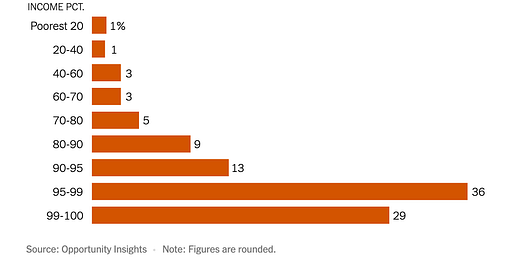After the SCOTUS declared race-based affirmative action unconstitutional, leftists set their sights on legacy admissions. Legacy was already their favorite whataboutism, never mind that there is no legal theory that prohibits preferences based on whether family members graduated from the same college.
While legacy goes against the idea of pure merit, it also has concrete benefits that the “diversity” rationale never had:
“Why would we want rich kids to have an even bigger advantage?” is the wrong question. When about 80% of legacy students have parents in the top 10% of income earners, this benefits other students. Few legacy admits will qualify for need-based scholarships, leaving those open for other students. Indeed, wealthy students paying full tuition and donating generously helps fund those who can’t afford tuition.
Donations
Legacy families are more likely to donate and donate big. Donations not just of money (though, yes, plenty of that), but donations of buildings, libraries — these benefit all students at the institution. The cash donations go towards funding scholarships for students who are academically excellent but can’t afford tuition.
Networking
Many legacy admits are related to high net worth individuals who are leaders in their industries and can link to job opportunities or give valuable advice, even mentorship.
Assortative mating
The smart can find the wealthy and amplify one another’s potential. This is true not just for romantic partnerships, but also for business partnerships.
Who bears the cost of remedial support
Colleges select students they believe will be able to thrive. Or at least achieve enough academic success to graduate. Knowing that a student has a family member who once graduated from the same school is a useful signal that the student either innately possesses the ability they need to graduate, or has a family that can step in and provide guidance as necessary. The university will not have to expend as many resources on legacy admits as those who are admitted with lower academic merit for other reasons.
Behavioral norms
Learning the behavioral norms of the elite helps smooth entry into that society for career, socialization, friendships, partnerships. Legacy friends who grew up in that world can help teach these conventions to the uninitiated.
Beyond these benefits to the college and other students, consider the effect on the student who is admitted with racial preferences.
The existence of large race-based affirmative action preferences confirms that even university administration agrees that but for preferences, hardly any students of a given race would qualify. If a vast majority of students in a given group would not have been admitted without the large racial preference, every member of that group will be seen as less competent until they prove otherwise. This is a problem. Supreme Court Justice Clarence Thomas famously said his law degree from Yale was worthless because law firms wouldn’t hire him — they assumed he got into Yale because he was black.
While Justice Thomas’ job market difficulties should no longer be a problem, with top firms clamoring to hire anyone of the right skin color lest they face scrutiny for being “too white”, the problem of mismatch remains. In short, large preferences mean a beneficiary will rank low in their class, leading to demoralization and opting out of STEM majors despite initial interest.
Another pernicious side effect is that peers can observe an obvious gap in ability when the preference is large. This effect applies when the group is easy to identify — for example, an expert witness for SFFA in its case against Harvard estimated that if admissions were on the basis of academics alone, less than 1% of the student body would be black vs the nearly 16% admitted for c/o 2025. It follows that the gap in ability will be obvious to other students and faculty. Is it good for the future leaders of the country to have an impression from repeated personal experience that members of a racial group are less capable on average and ready to cry “racism” if these differences are brought up?
On the other hand, legacy students perform about the same as non-legacy students, and even have a slight advantage over other applicants at elite colleges where they don’t have legacy preference.
I do not feel strongly about legacy admissions, but I do recognize that the more colleges admit on pure academic merit, the more academically competitive future legacy candidates will be. There are tradeoffs between merit and legacy — that’s how it differs from affirmative action. Legacy provides tangible benefits to other students, which is not the case for “diversity.” The main point of this exercise was to show that legacy is not a good rebuttal to racial preferences because:
There is no law prohibiting preferences based on whether family members attended the same school.
Legacy admissions come with concrete benefits to the university and other students.
Racial preferences harm every member of the group that receives preferences: those who need them, because they enroll at a school where they’re mismatched, and those who don’t, because everyone of that race is assumed to have benefitted from the preferences until they can prove otherwise.
Legacy preferences do not harm its recipients as in (3) both because legacy students are average (not clustered at the lowest academic ranks) and because legacy status is not as obvious as race.
Applicants of every race can benefit from legacy admissions, whereas racial preferences work against some races to benefit others.




So you are in favor of a hereditary aristocracy, noted. Pretty much 100% of your claims about the advantages of legacy admissions can be turned on their head and support affirmative action, which is what is really funny about this essay.
I would like really like some mentorship on how I can be born into a wealthy family please.